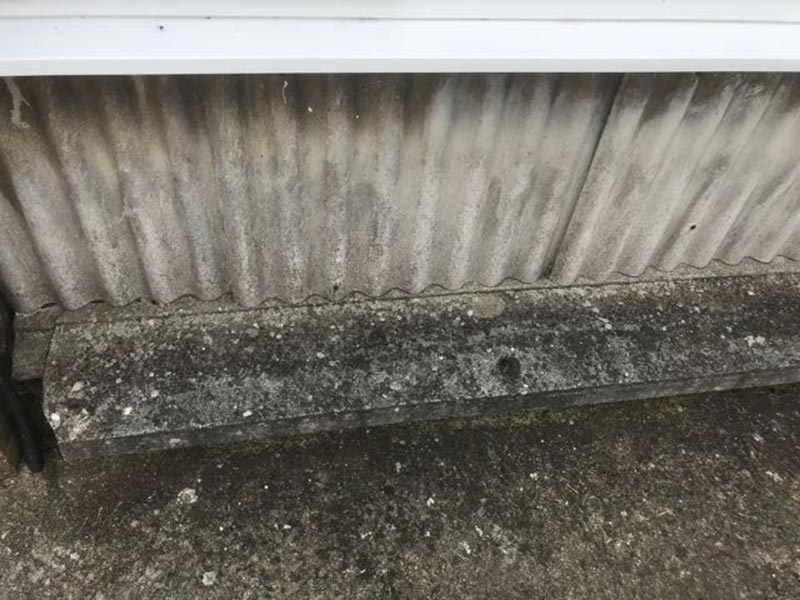What is friable asbestos? Understanding the differences, risks, and identification
The state of a material’s asbestos fibres determines whether it’s friable or non-friable. Non-friable materials can become friable over time. However, friable materials are that way from the beginning — they’re naturally friable.
Both types of asbestos-containing materials (ACMs) are considered toxic and cancer-causing. However, distinguishing the two types is important when it comes to assessing their risk and deciding how to maintain, repair, or remove the ACM.
Keep in mind that you can’t confirm the presence of asbestos by sight or smell. You’ll need a licensed asbestos contractor to test a sample and confirm whether or not asbestos is present. They will also be able to test the friability of the material.
What is friable asbestos?
According to the dictionary, the word “friable” means “easily crumbled or reduced to powder.”
In terms of asbestos, “friable” refers to ACMs that can easily crumble or be crushed into a powdery form. The resulting asbestos dust is extremely dangerous because of how easy it is to inhale.
Friable ACMs are susceptible to damage even when they’re brand-new. The fact that they’re easy to damage isn’t a result of time; it’s how the ACM is made.
Common sources of friable asbestos include the following:
- Asbestos rope
- Ceiling tiles
- Insulation boards
- Joint compounds
- Loose-fill asbestos
- Pipe lagging
- Plaster
- Popcorn ceiling
- Spray-on paints
- Surface coatings
- Thermal insulation
- Wallboards
An intact ACM isn’t dangerous. ACMs only become dangerous if they’re disturbed or damaged and release airborne fibres. Those fibres can stay in the air for days, and they’re so microscopic that people won’t even know they’re there.
If asbestos fibres are inhaled, they stick to the person’s lungs and can cause cancers and other asbestos-related diseases as far as four decades in the future. Asbestos-related diseases include:
- Asbestosis
- Colon cancer
- Kidney cancer
- Larynx cancer
- Lung cancer
- Mesothelioma
- Oesophagus cancer
- Oral cavity cancer
- Stomach cancer
Many of these diseases are life-threatening.
Differences between friable and non-friable asbestos
Non-friable asbestos is sometimes called bonded asbestos, referring to how the fibres are bound together. With a non-friable ACM, putting pressure on it with your hand won’t cause the materials to break down and come apart.
Non-friable ACMs include the following:
- Asbestos cement and cement sheeting
- Automotive brakes
- Bitumen sheeting
- Gaskets
- Roofing felt
- Siding
- Textured decorative coatings
- Vinyl floor tiles
It takes little effort to break, crumble, or fray friable ACMs and send the fibres airborne. Non-friable materials, on the other hand, can be damaged, but not simply by touch or with your hand.
That doesn’t make non-friable ACMs safe, though — it just means they’re less susceptible to certain types of disturbances.
Even non-friable ACMs can become crumbled or powdery over time due to accidental damage, age, inclement weather, or normal wear and tear. Plus, any type of abrasive activity can potentially disturb ACMs and scrape or rub fibres off, sending them airborne.
While both friable and non-friable ACMs can pose a health risk if damaged, it’s easier to damage friable ACMs, which makes them more of a threat.
Additionally, friable ACMs typically contain more asbestos than non-friable ACMs. The more asbestos a material contains, the more friable and weaker it typically is.
Correspondingly, ACMs with a lower concentration of asbestos have fewer fibres to release. Not only is a non-friable ACM harder to damage, but if it is damaged, fewer fibres may become airborne.
Again, this doesn’t make those fibres safe, but it makes non-friable ACMs less risky overall.
How to determine if asbestos is friable
The condition of the ACM may tell you whether or not it’s friable. Loose material that can be easily crumbled, crushed, or turned into a powder is friable.
When ACMs deteriorate, it can be difficult to determine what they were in their original state. For example, it can be tough to tell the difference between broken-down asbestos board and asbestos cement.
The best way to determine whether or not you have friable asbestos is with expert sampling and testing. A sample of the ACM will be taken and sent to a lab for assessment.
To determine what you’re working with and the friability of the material, an Asbestos Density Test (also called a Water Absorption Test) is needed. This test measures how much water the material absorbs over time.
This is a specialised test that should only be conducted by an experienced professional.
It’s important to have this test done before you work with or remove the materials. That way, you’ll know what types of ACMs are present, and you can plan accordingly to ensure an exposure event doesn’t occur.
Mitigation and management of friable asbestos
If you discover that friable asbestos is present, you’ll want to hire a licensed professional to remove the ACMs. Since this job has such a high risk of damaging the ACMs and spreading the fibres, only someone with the proper training and experience should carry out the work.
There are a few different approaches to dealing with friable ACMs:
Encapsulation and sealing
This is when you apply a bonding agent or sealant to limit the friability of the ACM. The asbestos fibres are surrounded by an adhesive materials so they can’t become airborne.
You can use a product that creates a membrane on the ACM’s surface or a penetrating product that penetrates the material to bond its components.
Enclosure and isolation
This is when you enclose the ACMs in an airtight material, such as plastic or a permanent covering. Depending on the affected space, you may have to isolate that ACM instead of enclosing it. Either way, the idea is to section off the ACM and any resulting asbestos dust.
Removal and abatement
When ACMs are going to be removed, asbestos abatement happens first. This process controls the release of fibres so that the materials can then be safely removed.
It’s not safe to work with or remove friable asbestos on your own. You’ll need a specialist who can assess the situation, make a plan, and then remove and dispose of the ACMs following legal protocols. This is the only way to minimise the risks.
Licensed asbestos contractors will do the following:
- Assess your site and the ACMs present
- Identify the type of asbestos present
- Determine the risk level
- Offer advice for what to do next
- Remove and dispose of the asbestos
According to the Health and Safety Executive (HSE), asbestos work requires a licence if the materials are high-risk and hazardous.
The Control of Asbestos Regulations 2012 goes into this in more detail, which is outlined in the HSE’s licence application. While it doesn’t mention friability specifically, it says that licensable work is necessary “where the exposure to asbestos of employees is not sporadic and of low intensity,” as well as when work is to be carried out on asbestos coatings and insulation, both of which are friable ACMs.
Final thoughts about friable asbestos
While asbestos has been prohibited in the UK since 1999, it’s still present in many buildings that were constructed before then. Friable asbestos poses the greatest risk because it so easily breaks down and releases toxic asbestos fibres.
The only way to determine the friability of an ACM is with testing conducted by an asbestos specialist. You’ll also need licenced contractors to work on friable ACMs, whether you opt to have the materials encapsulated, enclosed, or removed.
Contact us if you’re in need of professional advice or assistance to address asbestos in your building.

Written by Callum McDonald
Callum McDonald is an expert in asbestos quality management, ensuring rigorous adherence to regulations and high-quality standards in removal projects. His focus on enhancing quality and client satisfaction makes him a crucial asset in safety and compliance within the field. Callum's expertise in technical support and oversight of licensed works underscores his commitment to excellence in asbestos management, providing invaluable guidance to clients in this specialised area.

